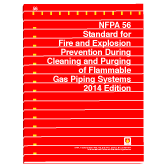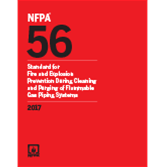
NFPA (Fire) 56
Product Details
- Published:
- 11/29/2022
- ISBN(s):
- 9781455929665
- ANSI:
- ANSI Approved
- Number of Pages:
- 60
- Note:
- This product is unavailable in Ukraine, Russia, Belarus


Click here to purchase
Apply the latest safe procedures for cleaning and purging flammable gas piping systems with this important new edition of the industry benchmark, NFPA 56.
Without proper safety protocols in place, charging or evacuating flammable gas piping systems can be a dangerous endeavor. NFPA 56: Standard for Fire and Explosion Prevention During Cleaning and Purging of Flammable Gas Piping Systems provides a valuable foundation for making safety-related decisions while developing procedures for these activities.
NFPA 56 presents key requirements for ensuring the development of safe procedures for cleaning and purging flammable gas piping systems, including:
Protect your personnel and your facilities from hazards using the 2020 edition of NFPA 56.
Provisions for written procedures for cleaning and purging activities now cover additional topics. The procedures are now required to address nonconductive components in temporary piping assemblies to account for the static charge that might be induced by those components. Written procedures must also address protection and rescue of personnel, including the selection of fire-resistant clothing based on a hazard analysis in accordance with NFPA 2113: Standard on Selection, Care, Use, and Maintenance of Flame-Resistant Garments for Protection of Industrial Personnel Against Short-Duration Thermal Exposures.
Safety begins with adequate training on hazard mitigation.
New training requirements in Chapter 5 help you ensure that knowledge transfer is evident in the training program and the appropriate information is maintained in the training records. Bring everyone in your facility up to speed with the latest edition of NFPA 56.

Click here to purchase
Charging or evacuating flammable gas piping systems can be a dangerous endeavor without proper safety protocols in place. NFPA 56: Standard for Fire and Explosion Prevention During Cleaning and Purging of Flammable Gas Piping Systems provides a valuable foundation for making safety-related decisions while developing procedures for these activities.
The 2014 NFPA 56 contains many key requirements for ensuring the development of safe procedures for cleaning and purging flammable gas piping systems, including:
The NFPA 56 framework can be adapted to almost any industrial environment where flammable gas is used. This edition has been updated to reflect some requirements where pressure relief valves and their associated piping are used to discharge gas during a cleaning or purging process. (In some plants, it is not possible to bypass the pressure relief devices during these steps.)

Click here to purchase
Apply the latest safe procedures for cleaning and purging flammable gas piping systems with this important new edition of the industry benchmark, NFPA 56.
Without proper safety protocols in place, charging or evacuating flammable gas piping systems can be a dangerous endeavor. NFPA 56: Standard for Fire and Explosion Prevention During Cleaning and Purging of Flammable Gas Piping Systems provides a valuable foundation for making safety-related decisions while developing procedures for these activities.
NFPA 56 presents key requirements for ensuring the development of safe procedures for cleaning and purging flammable gas piping systems, including:
Protect your personnel and your facilities from hazards using the 2017 edition of NFPA 56.
Provisions for written procedures for cleaning and purging activities now cover additional topics. The procedures are now required to address nonconductive components in temporary piping assemblies to account for the static charge that might be induced by those components. Written procedures must also address protection and rescue of personnel, including the selection of fire-resistant clothing based on a hazard analysis in accordance with NFPA 2113: Standard on Selection, Care, Use, and Maintenance of Flame-Resistant Garments for Protection of Industrial Personnel Against Short-Duration Thermal Exposures.
Safety begins with adequate training on hazard mitigation.
New training requirements in Chapter 5 help you ensure that knowledge transfer is evident in the training program and the appropriate information is maintained in the training records. Bring everyone in your facility up to speed with the latest edition of NFPA 56.